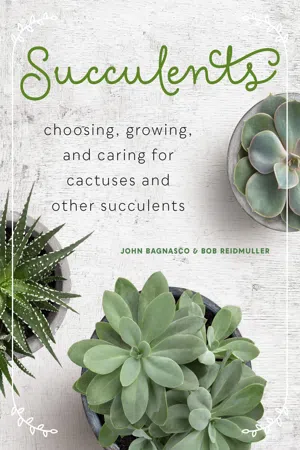
Succulents
Choosing, Growing, and Caring for Cactuses and other Succulents
- 112 pages
- English
- ePUB (mobile friendly)
- Available on iOS & Android
Succulents
Choosing, Growing, and Caring for Cactuses and other Succulents
About This Book
Loved the world over for their unique beauty and lower maintenance requirements, this gift-able edition of Succulents shows you how to choose and take care of the ever-popular succulent. Cactuses and other succulentsare wildly popular in homes the world over, regardless of climate. They're resilient, beautiful, and easy to care for as long as you know what you're doing.Whether you live in a warm, dry climate and want to grow a whole cactus garden outdoors or you'd like to add one of these alluring species to your indoor windowsill, this book has what you need to pick the perfect plants for you and make them thrive. With this all-inclusive guide, you'll get all theinformation you'll needon:
- Color combinations
- Sizes and shapes
- Container growing
- Watering
- Grooming
- Propagation
Learneverything you need to know about succulents! Includes more than 100 plant profiles with corresponding color photography, with details that will help you succeed in gardening prickly and waxy varieties of all kinds.
Frequently asked questions
Information
1



Table of contents
- Cover
- Title Page
- Contents
- Introduction: More Than Hens and Chicks
- 1| What Are Cactuses? What Are Succulents?
- 2| Cactuses and Succulents Outdoors
- 3| Cactuses and Succulents Indoors
- Featured Plants: 100 Top Choices of Cactuses and Succulents
- Index
- About the Authors
- Copyright